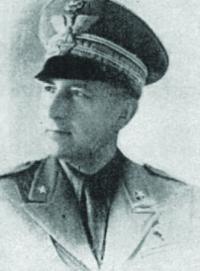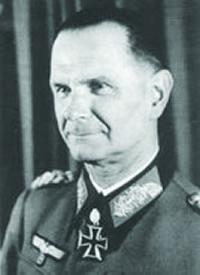
General Antonio Gandin, commander Acqui Division.

General Karl Hubert Lanz, commander XXII Mountain Corps, wearing Knight's Cross.

Carlo Vecchiarelli, General Officer Commanding 11th Italian Army, Greece.

Padre Romualdo Formato, one of Acqui Division's seven chaplains and one of the few survivors.

Monument to the Acqui Division on Cefalonia.
THIS WEEK, 70 years go, German soldiers of the First Mountain Division and the 104th Jäeger Division assaulted their erstwhile Italian allies of the Acqui Division, commanded by General Antonio Gandin, on the Greek Island of Cephalonia. At 302 square miles in size, it is the largest of the Ionian Islands on the west coast of Greece. The island currently has a population of 36,000.
The Acqui Division had been occupying the island since May 1943 and had been commanded by General Gandin since June 18. The division consisted of 11,500 soldiers and 525 officers and had participated in ItalyÙs brief war with France. General Gandin had served on the Eastern Front, with the Eighth Italian Army, and had been awarded the German Iron Cross. On July 6, 2000 soldiers of the 966 Fortress Grenadier Regiment, under the command of Lt. Col. Johannes Barge arrived on the island to "assist" the Acqui. Col. Barge was also an Eastern Front veteran and Iron Cross holder.
On July 25, 1943, the inconceivable had occurred - Il Duce di Italia was deposed, and then arrested! King Victor Emmanuel III appointed Marshal Pietro Badoglio Prime Minister. Even though Mussolini had been deposed and was now under arrest, Marshal Badoglio continued to, publically, espouse Italian support for the Axis war effort, all the while secretly negotiating surrender terms with the Allies. In fact, the Marshal agreed to, and did, place the Italian armed forces under German command.
The following month General Giuseppe Castellano clandestinely traveled to Lisbon to negotiate ItalyÙs capitulation to the Allies. On September 3, 1943, General Castellano secretly signed the surrender documents aboard the British battleship HMS Nelson, off Sicily. General Walter Bedell Smith executed the documents on behalf of the Allies. The parties agreed that the surrender would not be announced until September 12, in order to give the Italians time to rearrange their forces to resist the Germans. However, the Americans "jumped the gun," and announced it four days early. The Germans had been planning for this event ever since Mussolini was deposed, and had quietly moved additional units into Italy.
The day that the surrender was announced, General Carlo Vecchiarelli, commander of the Italian occupation forces in Greece, telegrammed General Gandin not to attack the Germans or aid the Greek partisans or the Allies. The soldiers of the Acqui Division were happy because they thought that they would be going home soon.
At 9:00 A.M. on September 9, Col. Barge met with Gen. Gandin. Two days later, Commando Supremo ordered General Gandin that, "German troops have to be viewed as hostile," and that, "disarmament attempts by German forces must be resisted with force." At the same time, Colonel Barge handed the General an ultimatum, giving him three options: (1) continue fighting on the German side; (2) fight against the Germans; (3) hand over arms peacefully. This series of events placed General Gandin in a terrible position, because Marshal Bagdolio had placed the Italian Armed Forces under the command of the Germans. If General Gandin disobeyed a German command, especially if he entered into hostilities with them, that could be interpreted as treason, punishable by death. Moreover, if he surrendered his divisionÙs weapons to the Germans, he would be violating the orders of his Italian superiors.
Faced with this dilemma, Gandin met with his senior officers and the divisionÙs seven chaplains. All advised compliance with German demands. Gandin felt that he could not do that, so he continued negotiating with Barge, ultimately agreeing to withdraw from the important position of Mount Kardakata, which dominated the island. On September 12, Gandin informed Barge that he was going to surrender the divisionÙs weapons if no further Germans were brought to the island. The next day, five German ships approached the island. The Italian officers commanding the shore batteries opened fire, sinking two and killing five. That night a poll was taken of the troops, with a majority favoring resistence. The next morning, Gandin reneged on his promise to give up his divisionÙs weapons and told the Germans to leave the island. The following morning, the Luftwaffe sent in the Stukas. In the ensuing battle, 400 Germans were captured.
On September 17, elements of the 1st Mountain and 104th Jäeger Divisions, under the command of Major Harald von Hirshfeld, arrived. They were a part of the newly-formed XXII Mountain Corps, under the command of Karl Hubert Lanz. The next day, the German High Command ordered that, "...because of the perfidious and treacherous behavior on Cephalonia, no prisoners are to be taken." Meanwhile, the Allies prohibited the Italians from sending aid or reinforcements because they feared that the reinforcements would side with the Germans! Having run out of ammunition and suffered 1315 dead, Gandin, unaware of the "no prisonersÙ order, surrendered on September 22. The Germans counted 300 dead.
Executions began immediately. When some Bavarian soldiers protested, they were threatened with the same treatment. On September 23, General Lanz, who was on the island, reported to Berlin, "Final mopping up...is under way. General Gandin and his staff were captured. Special treatment in compliance with Führer order." The next day, General Gandin, and 137 senior officers were court-martialed for treason, and executed. After the executions, the Germans "salvaged" the ItaliansÙ boots. Some of the bodies were then loaded onto rafts and 20 Italian sailors forced to take them out to sea. The Germans then blew up the rafts, killing the sailors. Others were burned in open-air pyres. 5000 Italian soldiers were executed. Another 3000 died when the ships transporting them to POW camps struck mines in the Adriatic, and sank.
When Mussolini, who by then was old and spent and dependent on the Germans for everything, learned of the atrocity, in January 1944, his only response was, "But our men defended themselves, you know. They hit several German landing craft, sinking them. They fought how Italians know how to fight!"
General Lanz, who was on the island at the time of the murders, was the only person ever to face justice for these events, when he was tried in Nuremberg in 1948, where he was convicted and sentenced to 12 years incarceration. He was released after serving three years. Colonel Barge was not on the island at the time of the murders. Major von Hirshfeld became the WehrmachtÙs youngest general in December 1944 and would be killed in battle the following year.
The book, and movie, "Captain CorelliÙs Mandolin," was based on these events.
NEXT WEEK: SALÓ REPUBLIC
Mr. Wimbrow writes from Ocean City, Maryland, where he practices law representing those persons accused of criminal and traffic offenses, and those persons who have suffered a personal injury through no fault of their own. Mr. Wimbrow can be contacted at
wimbrowlaw@gmail.com
«Go back to the previous page.




